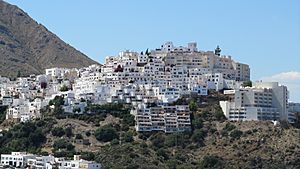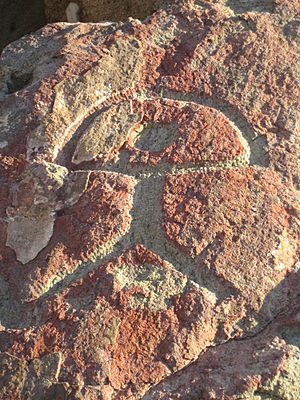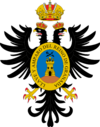Mojácar facts for kids
Quick facts for kids
Mojácar
|
||
|---|---|---|
|
Municipality
|
||
 |
||
|
||
| Country | Spain | |
| Autonomous community | Andalusia | |
| Province | Almería | |
| Comarca | Levante Almeriense | |
| Area | ||
| • Total | 72 km2 (28 sq mi) | |
| Elevation | 152 m (499 ft) | |
| Population
(2023)
|
||
| • Total | 7,386 | |
| • Density | 102.6/km2 (265.7/sq mi) | |
| Demonym(s) | Mojaqueros | |
| Time zone | UTC+1 (CET) | |
| • Summer (DST) | UTC+2 (CEST) | |
Mojácar is a beautiful town in southern Spain. It is located in the southeast of the Province of Almería, in the region of Andalusia. This charming place sits right next to the Mediterranean Sea.
Mojácar is about 90 kilometers (56 miles) from Almería, the capital city of its province. The main part of Mojácar is an old mountain village. Its buildings are famous for their traditional white color. There is also a newer area called Mojácar Playa. This is a popular tourist spot right on the coast.
Contents
How Many People Live in Mojácar?
The number of people living in Mojácar has changed over the years. Like many towns, its population can go up and down. In 2023, about 7,386 people lived there.
| Historical population | ||
|---|---|---|
| Year | Pop. | ±% |
| 2006 | 6,406 | — |
| 2007 | 6,507 | +1.6% |
| 2008 | 6,805 | +4.6% |
| 2009 | 7,581 | +11.4% |
| 2010 | 7,745 | +2.2% |
| 2011 | 8,090 | +4.5% |
| 2012 | 8,173 | +1.0% |
| 2013 | 8,360 | +2.3% |
| 2014 | 6,838 | −18.2% |
| 2015 | 6,825 | −0.2% |
| 2016 | 6,490 | −4.9% |
| 2017 | 6,330 | −2.5% |
| 2018 | 6,301 | −0.5% |
| 2019 | 6,403 | +1.6% |
| 2020 | 6,778 | +5.9% |
| 2021 | 7,257 | +7.1% |
| 2022 | 7,527 | +3.7% |
| 2023 | 7,386 | −1.9% |
| Source: INE (Spain) | ||
Mojácar's Long History
Mojácar has a very long and interesting history. Many different groups of people have lived here over thousands of years.
Early Settlements and Ancient Visitors
People first settled in Mojácar around 2000 BC, during the Bronze Age. This was a time when people started using bronze tools. Later, traders like the Phoenicians and Carthaginians came to the area. They traded with the growing communities.
Under Greek rule, the settlement was called Murgis-Akra. This name slowly changed over time. It became Moxacar in Latin, then Muxacra in Arabic. Finally, it became the Mojácar we know today.
Medieval Times and New Rulers
Murgis-Akra and its lands became part of the Nasrid sultanate. This was a Muslim kingdom in southern Spain. Mojácar was on the border with the Christian kingdoms. Because of this, watchtowers and forts were built or made stronger in the 1300s.
On June 10, 1488, Mojácar became part of the Kingdom of Castile. This was a major Christian kingdom in Spain.
Growth, Decline, and New Beginnings
After joining Castile, Mojácar grew again. By the early 1700s, about 10,000 people lived there. However, in the mid-1800s, the town started to shrink.
Several bad droughts caused many people to leave. They moved to other parts of Spain, Europe, or Hispanic America. This decline stopped in the 1960s. That's when tourism began to bring new life and people back to Mojácar.
Mojácar's Sunny Climate
Mojácar enjoys a lot of sunshine! It gets more than 3,000 hours of sun every year. Rain is rare and usually light. The area gets only about 200 millimeters (8 inches) of rain each year.
The average yearly temperature is around 20 °C (68 °F). Winters are usually mild and not too cold. The temperature in Mojácar rarely drops below 4 °C (39 °F).
- In winter, the average temperature is between 10 °C (50 °F) and 18 °C (64 °F).
- In summer, the average temperature is between 26 °C (79 °F) and 32 °C (90 °F).
Because Mojácar is close to the sea, summer temperatures feel pleasant. Inland areas of Almería can get much hotter, sometimes reaching 40 °C (104 °F).
Mojácar's Culture and Traditions
Mojácar has a rich culture with unique symbols, art, and food.
The Indalo Symbol

The Indalo, also known as the Mojácar man, is a special symbol. Many people believe it brings good luck and protection. In the past, people painted this symbol on their homes. They thought it would keep away bad luck and protect them from storms. The Indalo looks like a person holding a rainbow with outstretched arms.
The original Indalo symbol is very old, about 4,500 years old. The oldest known one is in a cave in Vélez-Blanco. Artists and thinkers who came to Mojácar in the 1960s named the symbol "Indalo." They helped make it famous. Today, the Indalo represents the entire province of Almería. It has even become popular in other parts of Europe, like Brittany in France and Cornwall in England.
- Learn more about why Indalos are considered lucky
You might have seen the Indalo in movies too! In the 1982 film Conan the Barbarian, the character played by Arnold Schwarzenegger had Indalo symbols tattooed on him. This movie was filmed in the Almería province.
Creative Communities
Mojácar is home to the Fundación Valparaíso. This is a place where artists from all over the world can come to work. It was started by Beatrice and Paul Beckett. The foundation is in a 16th-century farmhouse on a working olive farm. It continues to welcome international artists.
Traditional Foods
The traditional dishes in Mojácar show its rural past. The food is simple but tasty. Some well-known dishes include:
- Gurullos
- Pelotas
- Gachas
- Migas
- Ajo Colorao
- Pescado frito (fried fish)
Fun Festivals
Mojácar celebrates many important festivals, called fiestas in Spanish. Here are some of them:
- Easter: This is a special time, especially on Thursday and Friday. There are processions with statues of Jesús Nazareno, Encuentro, and Cristo Yaciente.
- San Agustín: This festival honors the patron saint of Mojácar. It takes place on August 28.
- Romería de San Isidro: This is a pilgrimage festival on May 15.
- San Juan Hogueras: This festival celebrates the Bonfires of Saint John. It happens on June 23–24.
- La Virgen del Rosario: This honors the Virgin of the Rosary, who is the female patron saint of Mojácar. It is celebrated on October 7.
- Fiesta de Moros y Cristianos: This festival remembers a historical event. It celebrates the peaceful surrender of Mojácar to the Catholic rulers in the late 1400s. It is held on the weekend closest to June 10.
See also
 In Spanish: Mojácar para niños
In Spanish: Mojácar para niños



